Stellar Evolution II - Massive Stars
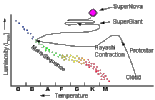
| H. E. Smith | Winter 2007 |

| Physics 7 - Lecture Summary #10 Stellar Evolution II - Massive Stars |
 |

Review evolution of a solar type star.
The evolutionary history of a star may be considered a story of the inexorable battle of the star against the force of gravity which, once the star begins its contraction out of the interstellar medium, attempts to pull it ever smaller into a more compact, more tightly bound sphere. Stars of solar-type masses will come to a compromise with gravity as they end their lives as compact, dense white dwarf stars with diameter about the size of the earth and density of order 1 ton/cm3. The most massive stars will lose this battle in spectacular fashion.
It follows that the single most important determinant of the life-history for a star is its mass; this principle is called the Russell-Vogt Theorem. Important mass regimes for stellar evolution:
 -
Planet. Jupiter, for example, has a mass of about 0.001 x
M
-
Planet. Jupiter, for example, has a mass of about 0.001 x
M . Jupiter's temperature is
slightly warmer than would be expected from the amount of solar energy it
receives; this is interpreted as due to gravitational potential energy
stored as heat from Jupiter's contraction out of the proto-solar nebula.
But the energy balance for Jupiter and other planets is largely determined
by the energy received from the sun and central temperatures never come close
to the 1 million K required for even the simplest nuclear reactions.
. Jupiter's temperature is
slightly warmer than would be expected from the amount of solar energy it
receives; this is interpreted as due to gravitational potential energy
stored as heat from Jupiter's contraction out of the proto-solar nebula.
But the energy balance for Jupiter and other planets is largely determined
by the energy received from the sun and central temperatures never come close
to the 1 million K required for even the simplest nuclear reactions.
 < M* <
0.085 M
< M* <
0.085 M -
Brown Dwarf;
these objects will never become hot enough in their cores to ignite the P-P
Chain. Release gravitational potential energy will cause them to heat up
to core temperatures as hot as 3 million K, hot enough for the first stages
of nuclear reactions, perhaps, but never hot enough to establish stable
hydrogen burning. With atmospheric temperatures
Tsurface < 2000K, brown dwarfs will be very faint,
radiating the vast majority of their luminous energy in the infrared, and
very hard to detect. A new near-infrared survey of the sky called 2MASS
has detected a large number of cool stars, now classified as
L-stars
which are likely to be brown dwarfs. Here's a
press release of another
possible brown dwarf detected at Palomar and the Hubble Space Telescope.
-
Brown Dwarf;
these objects will never become hot enough in their cores to ignite the P-P
Chain. Release gravitational potential energy will cause them to heat up
to core temperatures as hot as 3 million K, hot enough for the first stages
of nuclear reactions, perhaps, but never hot enough to establish stable
hydrogen burning. With atmospheric temperatures
Tsurface < 2000K, brown dwarfs will be very faint,
radiating the vast majority of their luminous energy in the infrared, and
very hard to detect. A new near-infrared survey of the sky called 2MASS
has detected a large number of cool stars, now classified as
L-stars
which are likely to be brown dwarfs. Here's a
press release of another
possible brown dwarf detected at Palomar and the Hubble Space Telescope.
 < M* <
0.4 M
< M* <
0.4 M - these stars will be very
long lived, but will never reach temperatures hot enough for the Triple-alpha
process to occur. They will not have a helium flash in the red giant stage
nor a helium-burning main-sequence phase.
- these stars will be very
long lived, but will never reach temperatures hot enough for the Triple-alpha
process to occur. They will not have a helium flash in the red giant stage
nor a helium-burning main-sequence phase.
 < M* <
1.2 M
< M* <
1.2 M - these stars
like the sun will burn hydrogen to helium via the P-P Chain and will burn
helium to crabon via the Triple-alpha process following a path through the
H-R Diagram essentially like that outlined in Lecture 9
.
- these stars
like the sun will burn hydrogen to helium via the P-P Chain and will burn
helium to crabon via the Triple-alpha process following a path through the
H-R Diagram essentially like that outlined in Lecture 9
.
 - these
stars will reach high enough core temperatures to burn hydrogen via the CNO
cycle.
- these
stars will reach high enough core temperatures to burn hydrogen via the CNO
cycle.
 - stars
more massive than about 8 solar masses (this number is very uncertain compared
with those above) will have a larger number of nuclear burning cycles and
their cores will be more massive than the limiting mass of
1.4M
- stars
more massive than about 8 solar masses (this number is very uncertain compared
with those above) will have a larger number of nuclear burning cycles and
their cores will be more massive than the limiting mass of
1.4M , the largest mass that can be
supported by electron degeneracy, and thus the largest possible mass for a
white dwarf. As we shall see these stars end their lives with a cataclysmic
explosion called a supernova.
, the largest mass that can be
supported by electron degeneracy, and thus the largest possible mass for a
white dwarf. As we shall see these stars end their lives with a cataclysmic
explosion called a supernova.
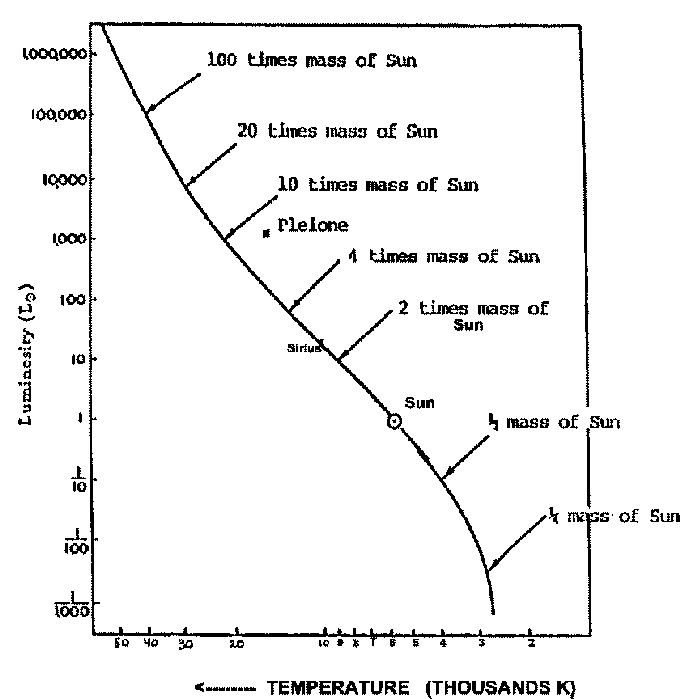
We may crudely distinguish between stars more massive than the sun and solar type stars in their evolutionary characteristics:
 M3.5
M3.5
Since the available fuel is effectively the mass of the star, the lifetime
will be approximately proportional to 1/Mass2.5. A star of 10
solar masses can thus be expected to go through its life cycle about 300 times
faster than the sun, with a main sequence lifetime of about 30 million years.
(The most massive stars have lifetimes shorter than about a million years,
while stars with masses less than about
3/4M have lifetimes longer than
the age of the Universe!)
have lifetimes longer than
the age of the Universe!)
 end their lives as white dwarfs.
end their lives as white dwarfs.
Confirmation of Stellar Theory -- Hertzsprung-Russell Diagrams
The "filmstrip" to the left shows the development of the H-R Diagram for a cluster of stars formed at a single epoch.
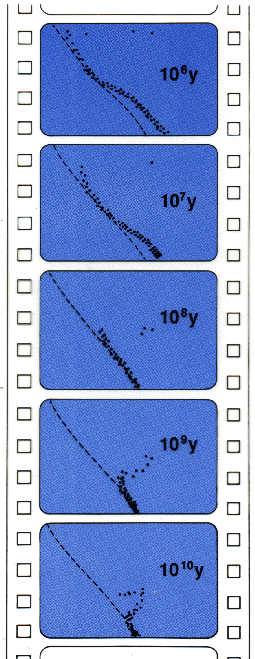 |
|
The theoretical H-R diagrams above can be compared with the schematic H-R Diagrams of a selection of clusters shown below.
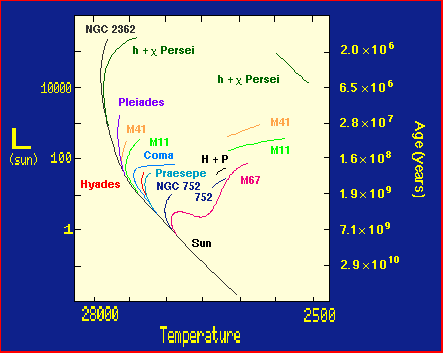
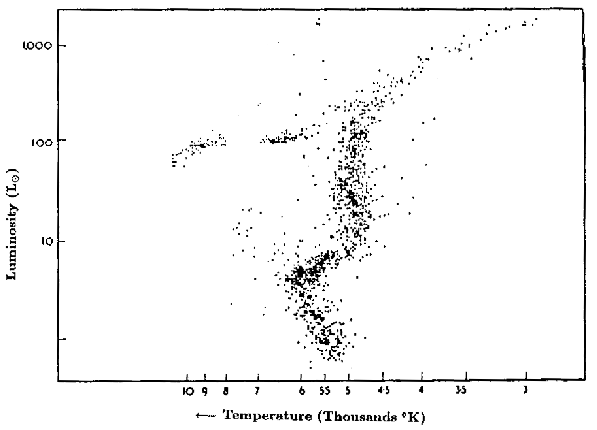

From considerations of the way in which the Milky Way formed, we believe that the globular clusters formed some 10-15 billion years ago, consistent with their ages determined from their H-R Diagrams.

![]() Supernovae & Neutron Stars
Supernovae & Neutron Stars
![]() Stellar Evolution #1
Stellar Evolution #1
![]() Physics 7 Lectures
Physics 7 Lectures
![]() Physics 7 Home
Physics 7 Home
Conducted by Gene Smith, CASS/UCSD.
Comments?
You may send email to hsmith@ucsd.edu
Prof. H. E. (Gene) Smith
CASS 0424 UCSD
9500 Gilman Drive
La Jolla, CA 92093-0424
Last updated: 16 April 1999